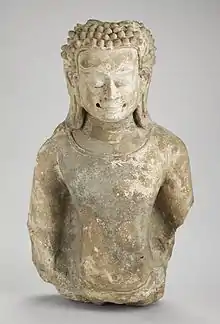Haripuñjaya (Pali) | |||||||||||
|---|---|---|---|---|---|---|---|---|---|---|---|
| 629–1292 | |||||||||||
.png.webp) Mainland Southeast Asia in 1100 CE | |||||||||||
| Capital | Haripuñjaya (Lamphun) | ||||||||||
| Common languages | Northern Thai Pali Mon Lawa | ||||||||||
| Religion | Theravada/Mahayana Buddhism | ||||||||||
| Government | Monarchy | ||||||||||
• 662-669, or 662-679, or 659-688 | Camadevi (Jamadevi)[lower-alpha 1] (first) | ||||||||||
• c. 1292 | (Phraya) Yi Ba (last) | ||||||||||
| Historical era | Middle Ages | ||||||||||
• Legendary founding by Suthep | 629 | ||||||||||
• More probable, supposed founding | c. 750 A.D. | ||||||||||
• Besieged and captured by Kingdom of Lan Na | 1292 | ||||||||||
| |||||||||||
Haripuñjaya[1][2][3] (Central and Northern Thai: หริภุญชัย RTGS: Hariphunchai, also spelled Haribhuñjaya) was a Mon kingdom in what is now Northern Thailand, existing from the 7th or 8th to 13th century CE. Its capital was at Lamphun, which at the time was also called Haripuñjaya.[4]: 77 In 1292 the city was besieged and captured by Mangrai of the Tai kingdom of Lan Na.[4]: 208
Founding
According to the Camadevivamsa and "Jinakalamali" chronicles, the city was founded by a hermit named Suthep in 629 AD, and the Mon ruler of Lavo Kingdom (present-day Lopburi) sent his daughter Jamadevi to become its first queen. However, this date is now considered as too early, and the actual beginning is placed at around 750 AD. At that time, most of what is now central Thailand was under the rule of various Mon city states, known collectively as the Dvaravati kingdom. Queen Jamadevi gave birth to twins, the older succeeding her as the ruler of Lamphun, and the younger becoming ruler of neighboring Lampang.
Flourishing and downfall

The kingdom under King Adityaraja, came into conflict with the Khmers in the twelfth century. Lamphun inscriptions from 1213, 1218, and 1219, mention King Sabbadhisiddhi endowing Buddhist monuments.[4]: 195
The chronicles say that the Khmer unsuccessfully besieged Haripuñjaya several times during the 11th century. It is not clear if the chronicles describe actual or legendary events, but the other Dvaravati Mon kingdoms did in fact fall to the Khmers at this time. The early 13th century was a golden time for Haripuñjaya, as the chronicles talk only about religious activities or constructing buildings, not about wars. Nevertheless, Haripuñjaya was besieged in 1292 by the Tai Yuan king Mangrai, who incorporated it into his Lan Na ("One Million Rice Fields") kingdom. The plan set up by Mangrai to overpower Haripuñjaya began by dispatching Ai Fa (Thai: อ้ายฟ้า) on an espionage mission to create chaos in Haripuñjaya. Ai Fa managed to spread discontent among the population, which weakened Haripuñjaya and made it possible for Mangrai to take the kingdom over.[5]: 38 [6][7][8] Phraya Yi Ba, the last king of Haripuñjaya, was forced to flee south to Lampang.[4]: 208–209
List of rulers
Names of monarchs of the Haripuñjaya kingdom according to Tamnan Hariphunchai (History of Kingdom of Haripuñjaya):
- Camadevi 662-669
- Hanayos 669-749
- Kumanjaraj 749-789
- Rudantra 789-816
- Sonamanjusaka 816-846
- Samsara 846-856
- Padumaraj 856-886
- Kusadeva 886-894
- Nokaraj
- Dasaraj
- Gutta
- Sera
- Yuvaraj
- Brahmtarayo
- Muksa
- Traphaka
- Uchitajakraphad, King of Lavo
- Kampol
- Jakaphadiraj, King of Atikuyaburi
- Vasudev
- Yeyyala
- Maharaj, King of Lampang
- Sela
- Kanjana
- Chilanka
- Phunthula
- Ditta
- Chettharaj
- Jeyakaraj
- Phatijjaraj
- Thamikaraj
- Ratharaj
- Saphasith
- Chettharaj
- Jeyakaraj
- Datvanyaraj
- Ganga
- Siribun
- Uthen
- Phanton
- Atana
- Havam
- Trangal 1195-1196
- Yotta 1196-1270
- Yip 1270-1292
Notes
- ↑ as "Queen"
References
- ↑ Robert L. Brown (1996). The Dvāravatī Wheels of the Law and the Indianization of South East Asia. Brill.
- ↑ Donald K. Swearer; Sommai Premchit, eds. (1998). The Legend of Queen Cāma: Bodhiraṃsi's Cāmadevīvaṃsa, a Translation and Commentary. State University of New York Press.
- ↑ David K. Wyatt (2004). Thailand: A Short History (2nd ed.). Silkworm Press. pp. 15, 21, 24–26, 34–37.
- 1 2 3 4 Coedès, George (1968). Walter F. Vella (ed.). The Indianized States of Southeast Asia. trans.Susan Brown Cowing. University of Hawaii Press. ISBN 978-0-8248-0368-1.
- ↑ Ministry of Education (1 January 2002). "Chiang Mai : Nop Buri Si Nakhon Ping". Retrieved 26 February 2021.
- ↑ "The Chiang Mai Chronicle / Summary". Archived from the original on 30 September 2021. Retrieved 26 February 2021.
- ↑ Janos Jany (8 April 2020). Legal Traditions in Asia: History, Concepts and Laws. Springer. p. 288. ISBN 9783030437282. Retrieved 26 February 2021.
- ↑ "Lanna". Retrieved 26 February 2021.
- 'Historic Lamphun: Capital of the Mon Kingdom of Haripunchai', in: Forbes, Andrew, and Henley, David, Ancient Chiang Mai Volume 4. Chiang Mai, Cognoscenti Books, 2012. ASIN B006J541LE
- Swearer, Donald K. and Sommai Premchit. The Legend of Queen Cama: Bodhiramsi's Camadevivamsa, a Translation and Commentary. New York: State University of New York Press, 1998.